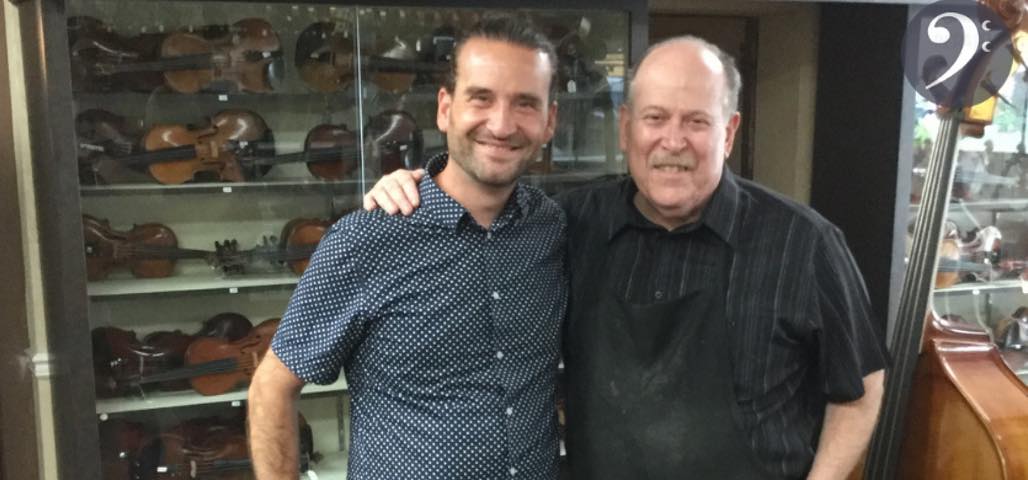As I was planning my trip to New York to do podcast interviews, I knew that I wanted to take a trip to visit Barrie Kolstein’s shop in Baldwin, New York on Long Island. This would be a great thing to do at any point, but the timeline was so cool, because it turns out that this is the year that Kolstein Music celebrates 70 years in business.
A Look at the History of Kolstein and Sons
Barrie and I had done a great podcast interview back in the mid-2000s with John Grillo, and we’d covered a lot of the history about how Samuel Kolstein started the business, Barrie’s time studying with Fred Zimmermann and Orin O’Brien, the remarkable group of jazz luminaries that Barre worked with as a student during the late 1960s and early 1970s, and how many of Barrie’s various products evolved.
Samuel Kolstein, Barrie’s father, founded the business in 1943 in Brooklyn, New York, and Barrie got involved in the business in the early 1970s after spending his childhood surrounded by the best bassists in the business.
Heading into the Shop
Walking into the Kolstein shop is a remarkable experience on so many levels. First of all, the visible store front makes for an optical illusion of sorts. You might think that this was one medium-sized shop from the outside, but upon entry you realize that they’ve actually bought and connected several other buildings to this original building, resulting in an expansive complex filled with various rooms and levels.
Barrie has a remarkable collection of Prescott basses in his shop, and like so many bass-related subjects, he has an encyclopedia knowledge of Abraham Prescott and his unique path into building basses.
Barrie has had a long history with the famous Prescott bass owned by Scott LaFaro. This bass was significantly damaged in the car accident that took Scott’s life, and this bass was restored by Barrie. It now resides in the Scotty LaFaro Archives at Ithaca College, with occasional trips back to the Kolstein shop for maintenance.
The Wall of Fame
Heading toward Barrie’s office, I stopped to marvel at the “wall of fame” featuring all sorts of well-known names in the bass world that had gotten basses, set-up work, and repairs from the Kolstein shop over the years. People like Milt Hinton, Slam Stewart, David Walter, Fred Zimmermann, Lisle Atkinson, Percy Heath, and even Kenny Rogers (!) grace the wall just outside of Barrie’s office.
The Kolstein shop also has practice rooms, and being able to bring in local teachers to teach lessons in the shop is a win-win benefit for teachers, students, and the shop. Ron Gilbert at Dallas Strings does the same thing in Allen, Texas, and I’ve seen this setup in several other shops as well.
In addition to their extensive collection of basses, the Kolstein shop has a robust selection of violins, violas, and cellos on display throughout the facility. In addition to being a destination shop for bassists and other string players, Kolstein Music runs a large rental program for area school orchestra programs.
Kolstein Rosin
Heading deeper into the facility, Barrie took me into the production room for the world-famous Kolstein rosin. I’ve been using Kolstein rosin for years, and I’ve always enjoyed the tone and sustain that I get with this rosin. In addition to making great rosin, Barrie came up with the idea of using a silicon case as opposed to foil or paper.
Silicon cases make a ton of sense for bass rosin. It seems to keep the rosin fresher longer, and it makes resining a much tidier experience. Instead of ripping off a section of foil or paper, you just roll the silicon down to apply rosin, and you then roll it back up when you’re done. Brilliant!
Much of the deeper areas in the shop are devoted to instrument repair and restoration, as well as bass building. In addition to managing all the others aspects of the shop, Barrie continues to build a few basses every year himself.
Kolstein travel trunks have been in use for decades at this point in the bass community, and Barrie has recently refined the design of the Kolstein travel trunk, trimming a few inches off of the height and continuing to achieve that tricky balance of making a case both protective and portable.
The Busetto Bass
No matter what you do with class design, flying with a full-sized bass remains a challenge. I’ve been a big fan of Barrie’s Busetto bass, which he designed several years ago for traveling bassists. Barrie actually removed “traveling” from the name of the instrument because he found that many bassists (including Miroslav Vitous) were using the Busetto bass as their main instrument.
The bass is much skinnier than a standard 3/4 size instrument, but it still manages to put out a full and resonant sound despite it’s smaller build. I tried one in person for the first time at the 2017 International Society of Bassists Convention, and I was astonished at how rich and complex a sound it produced.
Our “Round 2” Interview
Barrie and I talked about the Busetto bass, the icy legacy of bass players that he’s known through the years, what he has learned during his nearly 50 years in the business, how the music industry has (and hasn’t!) changed, and much more in this wonderful “round 2” conversation over a decade after our original chat. I hope you enjoy it!
Bass News Right To Your Inbox!
Subscribe to get our weekly newsletter covering the double bass world.

